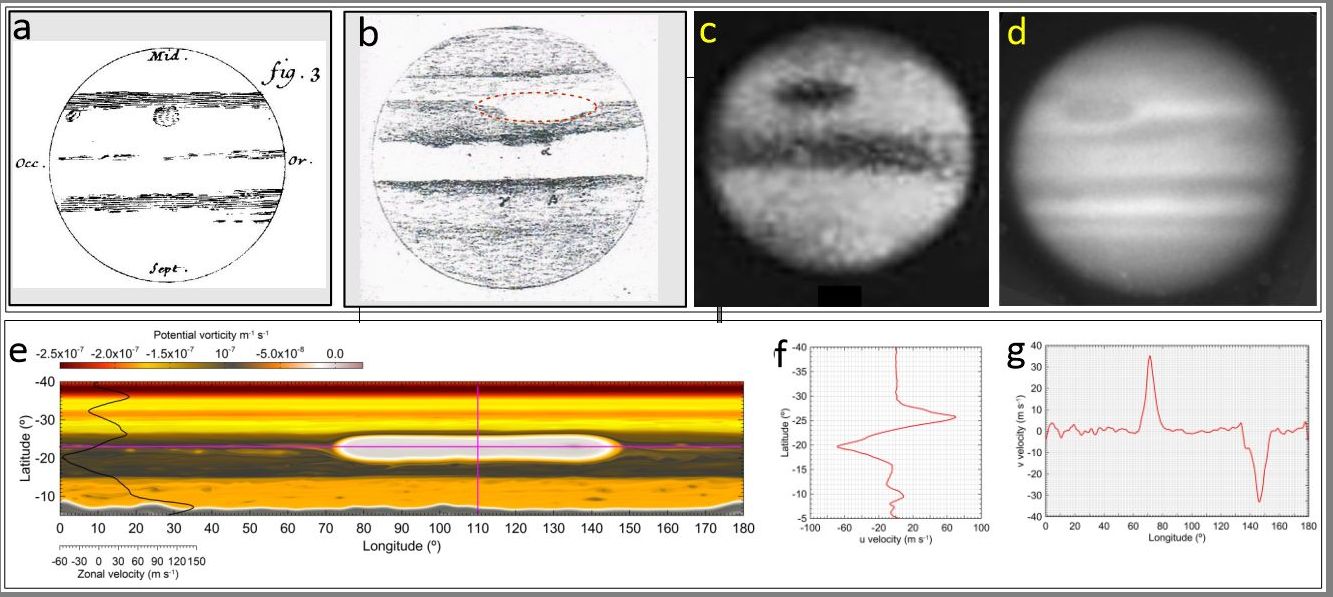On the origin of Jupiter’s Great Red Spot
- 1Universidad Pais Vasco UPV/EHU, Escuela de Ingeniería de Bilbao, Física Aplicada I, Bilbao, Spain (agustin.sanchez@ehu.es)
- 2Escola Superior d’Enginyeries Industrial, Aeroespacial i Audiovisual de Terrassa, Universitat Politècnica de Catalunya, Terrassa (Barcelona), Spain
- 3Barcelona Supercomputing Center, Barcelona, Spain
Jupiter's Great Red Spot (GRS) is probably the best known atmospheric feature and a popular icon among solar system objects. Its huge oval shape, contrasted red color and longevity, have made it an easily visible target for small telescopes. The GRS is the largest and longest-lived known vortex, an anticyclone, of all solar system planets but its lifetime is debated and its formation mechanism remains hidden. G. D. Cassini discovered in 1665 the presence of a dark oval at the GRS latitude, known as the “Permanent Spot” (PS) that was observed repeatedly by him and others, until 1713. After a long period of 118 years without observations of PS, it is in 1831 when the presence at the same latitude of an elongated cavity or hollow in the South Equatorial Belt (SEB) was reported. We show from measurements on historical observations of its size evolution, shrinkage rates, and motions of PS and the GRS and its hollow that the 1831 drawing represents the first record of the proto-GRS. Therefore, PS is unlikely to correspond to the current GRS, and if so, the GRS would be at least 193 years old. Until 1872, the proto-GRS was drawn as a clear oval enclosed by a dark elliptical ring, and it was from that year that was drawn and photographed as a red oval accompanied by the hollow in the SEB (Figure 1) [1].
Recent microwave and gravity field measurements made by Juno spacecraft indicate that the GRS length is likely to be much greater than its depth [2-3]. We have used a Shallow Water (SW) [4] and the Explicit Planetary Isentropic Coordinate (EPIC) [5] models operating for Jupiter upper troposphere conditions to perform numerical simulations on the origin of the GRS. We have explored three different dynamical mechanisms for its genesis: a “super-storm”, the merger of a chain of mid-scale anticyclones, and a long-cell resulting from a shear flow instability. Our numerical simulations rule out the first two scenarios and support that the proto-GRS formed from an instability known as the South Tropical Disturbance [6] that grows between the two opposed Jovian zonal jets north and south of the latitude of the GRS. If so, the early GRS should have had a low tangential velocity so that its rotation velocity has increased over time as it has shrunk.
[1] Sánchez-Lavega, A. et al., 2024. The origin of Jupiter’s Great Red Spot. Geophysical Research Letters (in the press).
[2] Bolton S. J. et al. (2021). Microwave observations reveal the deep extent and structure of Jupiter’s atmospheric vortices. Science 374, 968-972.
[3] Parisi M. et al. (2021). The depth of Jupiter’s Great Red Spot constrained by Juno gravity overflights. Science 374, 964-968.
[4] García-Melendo E., Sánchez-Lavega A. (2017). Shallow water simulations of Saturn’s giant storms at different latitudes. Icarus 286, 241–260.
[5] Dowling T. E., et al. (1998). The explicit planetary isentropic-coordinate (EPIC) atmospheric model. Icarus 132, 221–238.
[6] Rogers J. H. (2008). The accelerating circulation of Jupiter’s Great Red Spot. J. Brit. Astron. Assoc. 118, 14-20.

Fig. 1: (a) Drawing showing the Permanent Spot (PS) by G. D. Cassini, 19 January 1672. (b) Drawing by S. Swabe in 10 May 1851, showing the proto-GRS as a clear oval with approximate limits marked by a red dashed line. (c) Photograph by A. A. Common on 3 September 1879 showing the GRS as a prominently “dark” oval. (d) Photograph of the GRS and its hollow taken at Lick Observatory on 14 October 1890. (e) SW simulations of the proto-GRS as a circulating long-cell enclosed by a STrD instability. (f) (g) East-West and North-South velocity profiles across the elongated-cell center (marked by the red lines in (e)). All figures show the astronomical view of Jupiter (South up, East left). Adapted from [1].
How to cite: Sanchez-Lavega, A., García-Melendo, E., Legarreta, J., Miró, A., Soria, M., and Ahrens-Velásquez, K.: On the origin of Jupiter’s Great Red Spot, Europlanet Science Congress 2024, Berlin, Germany, 8–13 Sep 2024, EPSC2024-242, https://doi.org/10.5194/epsc2024-242, 2024.